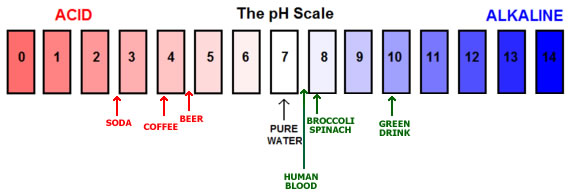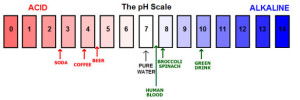
How can I get a list of alkaline/acid foods?
Balanced body chemistry pH (balance of alkaline and acid) is absolutely vital for immune health, supporting your body’s ability to heal itself and contributing to your overall well-being.
In order to feel your best, it’s critical that your body is comprised of more alkaline than acid. Our bodies keep large alkaline reserves to meet the demands of a diet containing acid-producing foods. When these reserves are depleted beyond a 3:1 ratio, your health can be threatened by allowing yeast, viruses, cancer cells, and parasites to thrive, which may contribute to conditions such as chronic fatigue, allergies, arthritis and others.
Also, if your body becomes too acidic, it will start calling on your body’s alkaline minerals like sodium, magnesium, potassium and calcium. If you continue to eat those acid-forming foods, you will create a mineral deficiency that can severely impact your health.
Here are some examples (remember lower pHs = more acidic, higher pHs = more alkaline)
Beef and poultry
Ham 6.3 – 6.4
Chicken 5.9 – 6.1
Canned meat 5.5 – 6.0
Frankfurt hot dog 5.7 – 6.2
Beef jerky 5.5 – 6.7
Bacon 5.5 – 6.2
Ground beef 5.1 – 6.2
Canned meats and soups 4.5 – 5.2
Seafood
Tuna 5.2 – 6.1
Shrimp 6.8 – 7.0
Fresh fish (mostly) 6.6 – 6.8
Salmon 6.1 – 6.3
Shellfish 4.8 – 6.3
Crustaceans 6.8 – 7.0
Dairy Products
Milk 6.3 – 6.5
Butter 6.1 – 6.4
Table cream 6.5
Cottage cheese 4.5 – 5.2
Mozzarella Cheese 5.1 – 5.3
UHT milk 6.2 – 6.5
Pasteurized fluid milk 6.5 – 6.8
Yogurt 3.7 – 4.4
Fruits
Apple 2.9 – 3.3
Banana 4.5 – 4.7
Orange 3.6 – 4.3
Strawberry 3.0 – 3.9
Plum 2.8 – 4.6
Dried fruit 3.7 – 4.4
Fruit canned in syrup 3.7 – 4.4
Fig 4.6
Fruit jam 3.5
Vegetables
Canned heart of palm 4.0 – 4.3
Canned corn 5.5 – 6.2
Beans 4.6 – 5.5
Broccoli 6.5
Asparagus 5.7 – 6.1
Brussels sprouts 6.3
Potato 5.3 – 5.6
Carrot 4.9 – 6.0
Corn 7.3
Olives 3.6 – 3.8
Beverages
Carbonated <3.7
Citrus juices <3.7
Fruit juices (some) <3.7
Sources: JAY (1973); BRIAN, F.L. (1997); IANFES (1991); LEWIS, M.J. (1993).
- pH >7.0 = Egg, grits, biscuits, black olives, corn.
- pH 6.5 – 7.0 = milk, chicken, ham, turkey
- pH 5.3 – 6.4 = beef, veal, vegetables
- pH 4.5 – 5.2 = canned meats and soups, cottage cheese, fermented vegetables
- pH 3.7 – 4.4 = cucumber pickle, mayonnaise, some fruits and juices, dried fruits, fermented vegetables, herring, tomatoes and yogurt.
- pH <3.7 = carbonated beverages, citrus juices, some fruit juices, most seasoned salads, pickles and vinegar.
Source: IANFES – 1991
